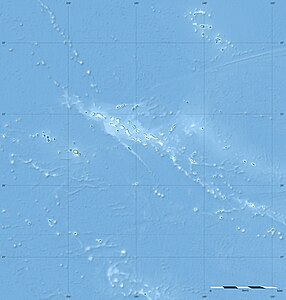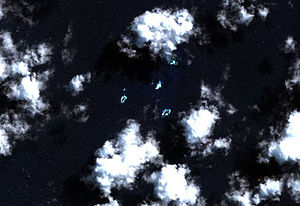Marotiri
| Marotiri | ||
|---|---|---|
| Marotiri: The Southern Rock ( îlot sud ) | ||
| Waters | Pacific Ocean | |
| archipelago | Austral Islands | |
| Geographical location | 27 ° 53 ′ S , 143 ° 29 ′ W | |
|
|
||
| Number of islands | 4th | |
| Main island | Îlot Sud | |
| Total land area | 0.043 km² | |
| Residents | uninhabited | |
| Map of Marotiri (Bass Rocks) | ||
Marotiri , also îlots de Bass ( German Bass Islands ), is not a singular island, but a group of ten small and tiny, uninhabited rocks in the Pacific Ocean with a common, submarine base. It belongs geographically to the archipelago of the Austral Islands and politically to French Polynesia and is administered by the municipality of Rapa .
geography
Marotiri is located in the extreme southeast of the Austral Islands, around 80 km southeast of the next inhabited island Rapa Iti and geographically forms with it the subgroup of the "Bass Islands".
Marotiri rises from a submarine plateau about 5 km in diameter at a depth of 100 meters. The four larger rock islands reach a height of up to 113 meters above sea level, the smaller ones are so low that they are constantly washed over by the surf. The islets are between 1.5 and 3 kilometers apart. The land area of the four larger together amounts to 43,100 m² (0.043 km²):
| rock | Area (m²) |
Height (m) |
|---|---|---|
| Îlot North | 5,800 | 62 |
| Îlot Central | 1,800 | 10 |
| Îlot Sud | 22,400 | 122 |
| Îlot Ouest | 13,100 | 97 |
| Marotiri | 43,100 | 122 |
The Bass Islands are in the subtropical climate zone, the climate is humid and temperate.
geology
The Austral Islands form a chain in the South Pacific that extends from southeast to northwest. They are the product of a hotspot under the still active Macdonald Seamount , which today is only about 40 meters below sea level at the southeastern end of the Austral Islands. The geologically oldest, more eroded and rugged islands are in the northwest, the younger ones in the southeast of the chain. The youngest of them is Marotiri.
Marotiri is of volcanic origin and consists of basaltic rocks with a high proportion of olivine sprinkles. These include basanites , basanitische tuffs and Hawaiite . The volcanic rocks are strongly undersaturated in silicon ( nepheline normative), sodium- emphasized alkaline rocks , as they can also be found on Macdonald-Seamount and on Tahiti . Their age is between 3.2 and 5.5 million years, but they are also dated somewhat younger at 3.0 to 2.7 million years.
flora
Although the bare rocks appear without vegetation at first glance, a closer examination by the botanist Francis Raymond Fosberg in 1934 showed that they do have traces of vegetation. A sparse, low-growing flora exposed to constant salt spray is only found in the higher areas of the four larger islands. It consists of: Bidens saint-johniana , a Digitaria species, grasses of the genus Cyperus , Portulaca lutea , Solanum nigrum and Solanum carolinense as well as an unspecified milkweed plant ( Euphorbia ). Three different ferns grow in protected crevices : striped ferns ( Asplenium ), lip ferns ( Cheilanthes ) and sword ferns ( Nephrolepis ). On the lower steep slopes there is a wolfberry species ( Lycium ) and some rocks are sparsely covered with lichens .
fauna
Compared to the low biodiversity of the flora, the terrestrial fauna - exclusively small organisms such as insects , spiders , millipedes and woodlice - is surprisingly diverse and numerous.
A group of researchers, including the American entomologist Elwood Curtin Zimmerman , landed on Marotiri on July 22, 1934. An inventory showed that ticks , mites , silverfish , rock jumpers , springtails , crickets , ants and ground bugs lived on the rock . The researchers also saw flies and moths of unspecified species.
Six species of spiders were discovered: Ariadna lebronneci, Theridion adamsoni, Ostearius melanopygius, Lycosa tanna, Australaena hystricina and Pseudomaevia insulana .
Zimmerman collected a single specimen from a bush of Bidens saint-johniana , on which it seems to feed , of the previously unknown beetle species Miocalles superstes (synonyms: Microcryptorhynchus superstes , Rhyncogonus zimmermani ) . Another, somewhat smaller species of the genus, Rhyncogonus variabilis , probably prefers the Portulaca lutea as a food plant .
The higher islands are important resting and breeding areas for several seabird species , especially shearwaters and tropical white-tailed birds . Shearwaters breed on ledges and between the tufts of grass. In the absence of predators , the unprotected eggs and young are safe even in the open areas.
history
It hardly seems possible that Marotiri was ever inhabited, as the islands do not offer any resources for human life. In particular, there are no fresh water sources. Nevertheless, Thor Heyerdahl's "Norwegian Archaeological Expedition to Easter Island and the East Pacific" found six stone structures that came from native Polynesians during a visit to Southern Rock on June 17, 1956.
It is not known whether the structures were built by permanent residents or by temporary visitors who caught birds, collected bird eggs and fished in the surrounding waters. The most striking structure is a rectangular tower made of unworked stones and without mortar on the saddle between the highest point on the island and the south-western tip. The tower measures 2.1 × 1.4 m and is 2.2 m high. There are other, rectangular, round and semicircular stone structures whose function and age are unknown. They are no more than 1.4 m high and only one to two meters in diameter.
The Frenchman Jean Guilin, author of a travel guide to the Austral Islands, concludes that on the Southern Rock there was once a fortress of the Polynesian natives, which was built by the tribes of the neighboring island of Rapa to protect the fishing areas and as a place of refuge.
There was speculation that the four larger islands of the Bass Rocks, which are also visible when driving past, are identical to the group "Las Cuatro Coronadas" mentioned by Pedro Fernández de Quirós . This assumption has not yet been proven.
Marotiri was discovered for Europe in 1800 by the British ship's doctor and explorer George Bass .
Individual evidence
- ↑ Bernard Salvat, Tamatoa Bambridge, Donatien Tanret, Jerôme Petit (eds.): Environnement Marin des Îles Australes, Polynésie Française, Tahiti 2015 , p. 30
- ↑ [1]
- ^ JM Liotard and Hans Gustave Barsczus: Contribution à la connaissance pétrographique et géochimique des îlots Marotiri, Polynésie française (Océan Pacifique center-Sud) . In: Comptes Rendus de l'Académie des Sciences, Paris, Series 2 . tape 301 (9) , 1985, ISSN 0249-6305 , pp. 611-614 .
- ↑ Valérie Clouard and Alain Bonneville: Ages of seamounts, islands and plateaus on the Pacific plate . In: Foulger, GR, Natland, JH, Presnall, DC and Anderson, DL, (Eds.): Plates, plumes, and paradigms, Geological Society of America Special Paper No. 388, pp. 71-90
- ^ Dieter Mueller-Dombois , F. Raymond Fosberg: Vegetation of the Tropical Pacific Islands , Springer-Verlag, New York-Berlin 1998, ISBN 0-387-98313-9 , p. 402
- ^ A b c F. Raymond Fosberg: Morotiri (Bass Rocks) Austral Islands. In: Atoll Research Bulletin No. 162, December 31, 1972, Smithsonian Institution , Washington DC, pp. 9-10
- ↑ Lucien Berland: Polynesian Spiders , Occasional Papers of Bernice P. Bishop Museum, Volume 17, No. 1, Honolulu 1942, p. 3
- ↑ Elwood C. Zimmerman: A Cryptorrhynchid from Marotiri (Coleoptera, Curculionidae) , Bernice P. Bishop Occasional Papers No. 21, Honolulu 1936
- ^ Edwin C. Van Dyke: Rhyncogonus of the Mangarevan Expedition , Occasional Papers of Bernice P. Bishop Museum, Volume 13, No. 11, Honolulu 1937, p. 91
- ↑ Edwin N. Ferdon: A Summary of Rapa Iti Fortified Villages, in: Reports of the Norwegian Archaeological Expedition to Easter Island and the East Pacific, Volume 2, Gyldendal, Copenhagen 1965, pp. 70-71
- ↑ Jean Guillin: L'Archipel des Australes. Editions A. Barthélémy & Editions Le Motu, Avignon, 2001, ISBN 2-87923-138-8
- ↑ Alexander George Findlay: A directory for the navigation of the Pacific ocean , London 1851
- ^ John Dunmore: Who's who in Pacific Navigation. University of Hawaii Press, Honolulu 1991, ISBN 978-0-8248-1350-5 , p. 16.



